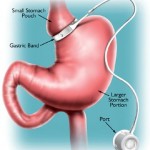LABG as Day Surgery is Quick and Safe
Thursday, February 25, 2010 This week, I am in Guadalajara, Mexico, to speak at the Congreso Hospitales Civiles 2010.
This week, I am in Guadalajara, Mexico, to speak at the Congreso Hospitales Civiles 2010.
Mexico, as does most of North America, has a burgeoning obesity crisis, where the number of people struggling with excess weight far outweighs the ability of the health care system to provide even just a “band-aid” solution to the problem.
As in Canada, treatments for people struggling with severe obesity is limited and offered by only a handful of surgical centres – mostly to people who can afford it.
While in Canada, the public healthcare system is only gradually beginning to tackle the issue of providing adequate access to bariatric surgery, most of the bariatric surgery in Canada is in fact delivered in the private setting.
Thus, an increasing number of private centres across Canada are providing laparoscopic adjustable gastric banding (LABG), a procedure that is not covered by the public health care system in most provinces.
The fact that this procedure can indeed be provided safely in a non-hospital setting is now documented in a paper by Chris Cobourn and colleagues from the Surgical Weight Loss Centre just published in Obesity Surgery.
In this paper, Cobourne report on the perioperative complications (30 days) in a retrospective analysis of 1,641 consecutive patients who underwent outpatient LAGB, beginning with their initial experience in February 2005 and continuing to July 2009.
The average presurgical body mass index was 46.7, of whom around 60% had at least one weight-related chronic disease.
Fifteen patients (~1%) experienced minor complications during or within 30 days of surgery (dysphagia, n = 5; wound infection, n = 3; port infection, n = 2; all other complications occurred in one patient each). Four patients required transfer to hospital from the clinic on the day of surgery, and three were admitted. Apparently, none of the complications were serious and all were resolved. The device was explanted in two patients.
Notably, the average time from sedation to discharge was less than 4 hours.
While this study does not report on the long-term outcomes of these patient, and 30 days is of course only a tiny window in what is a lifelong disorder, the paper does clearly show that LAGB can indeed be safely performed in a non-hospital outpatient setting.
Although LABG may not be the “gold standard” for bariatric surgery, it certainly is a technique that is surgically quick and easy. This, however, should not distract from the fact, that long-term success with any form of bariatric surgery is anything but quick or easy – rather, as I have blogged before, to succeed with bariatric surgery patients have to make extensive and persistent lifestyle changes and will often require long-term medical and psychosocial support.
Among all of the various bariatric surgical techniques, LABG is certainly the one that is most dependent on patient’s ability to change their dietary behaviours and of course, the bands do require periodic readjustment in order to continue to be effective.
We certainly look forward to seeing the long-term results in these patients before accepting that quick and safe also translates into best.
If you perform, look after patients who’ve had, or have had this surgery yourself, I’d love to hear from you.
AMS
Guadalajara, Mexico


